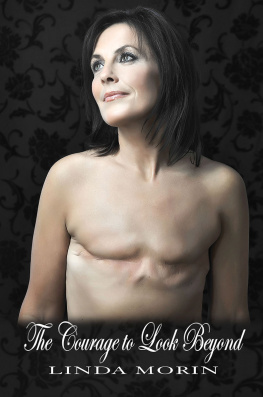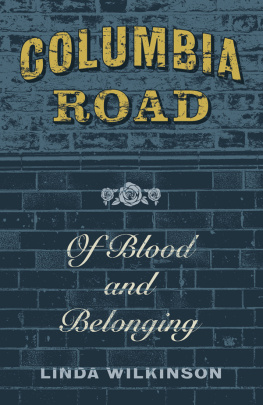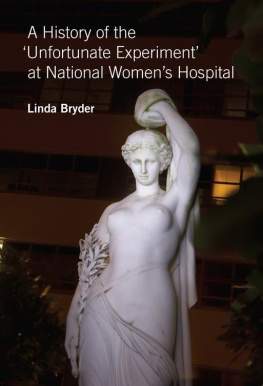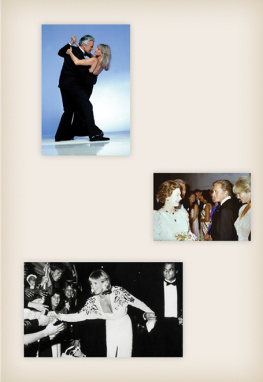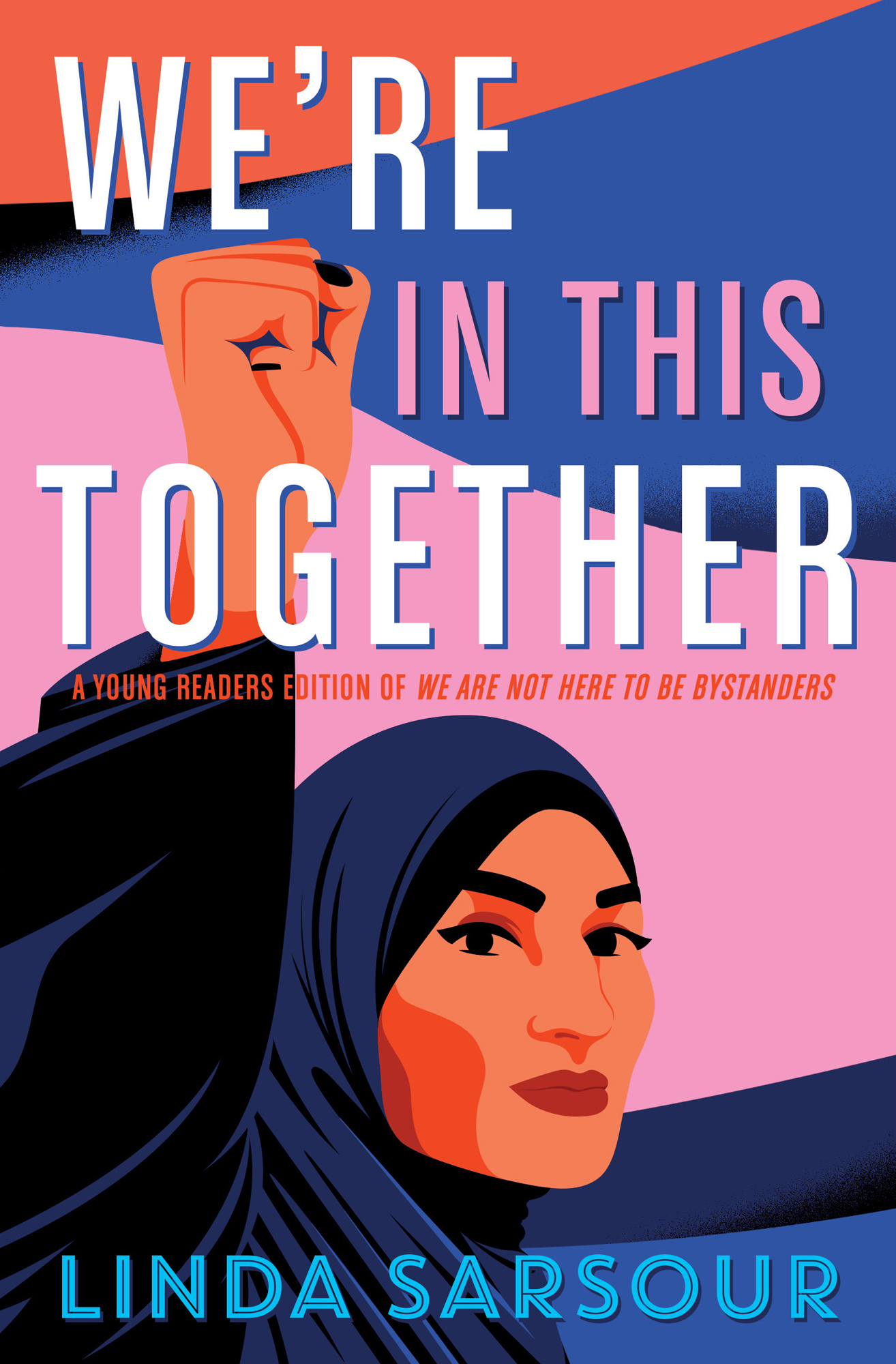Contents
Guide
Were in This Together
A Young Readers Edition of We Are Not Here to Be Bystanders
Linda Sarsour
To young students everywhere: I see you, I believe in you, and always remember, were in this together.
CHAPTER 1 The Womens March
Signs danced above an ocean of people like boats bobbing on the sea. White signs, red signs, black signs, pink signs, proclaiming beautiful messages of unity.
LOVE TRUMPS HATE , declared a white sign with rainbow-colored letters.
WE THE PEOPLE ARE GREATER THAN FEAR , black letters on a yellow placard pronounced.
FIGHT LIKE A GIRL! shouted the pink letters beneath a picture of a red fist cradled by a garland of green.
On a January morning in 2017, I stood backstage during the Womens March on Washington. Under a silver sky, with the cool breeze at my face, I saw a pink expanse spread before me in every direction, a patchwork quilt of baby pink, blush, neon pink, fuchsia. I could hear women talking to one another in a low hum, but their signs shouted their messages loudly.
WHEN THEY GO LOW, WE GO HIGH!
THE FUTURE IS FEMALE!
Where did all these women come from? I wondered.
I imagined mothers and daughters, sisters and sister-friends, classmates and coworkers from all over the country days earlier. In my minds eye I saw them gathered in kitchens over pizza and soda, or spread out on the carpet on living room floors. I heard them conversing with one another.
What do you want to say on your poster?
Dump Trump!
No. Why not something more positive about the society we want to create?
I imagined them thoughtfully penciling their messages onto poster board, contemplating their favorite colors, and then carefully coloring in the letters. Even from the stage, I could smell the sharp odor of the markers.
This was the morning Id been waiting for. The morning that we, the women of the United States and our allies, would stand up against the forces of hate and division and make our voices heard.
But I gotta be honest: even as one of the organizers, I was stunned by how many women already stood on Independence Avenue at the southwest corner of the United States Capitol grounds. I turned my head to the left and saw people crammed down the side streets. To the right people were sandwiched into those roads as well. Some women even had babies swaddled to their chests, the babies cheeks as bright as the knit caps that had become the signature look of the march. Behind the crowd, the Capitol gleamed white with the promise of democracy.
One of my closest friends, Tamika Mallory, walked over.
What time is it?
Its like eight fifteen, I answered.
There are so many people that I cant see the back of the crowd! she exclaimed.
Tamika was one of my besties. Over the years, together with our friend Carmen Perez, we had supported each other more times than we could count as wed fought for justice and equality for everyone. We were so close that we could read each others minds. Some people had begun to think of us as a social justice Voltron, so-called after the 1980s cartoon featuring a group of teens who teamed up to build and pilot a robot, Voltron, that defends the universe.
Just three months earlier the Voltron and fashion designer Bob Bland had been named one of the marchs lead organizers, back when the event had been just an idea dancing in our collective imagination. At that point we had been determined and passionate but uncertain about whether our idea for the march would work. Now a seemingly endless expanse of people stretched before us.
Together Tamika and I walked toward the front of the stage.
Directly ahead, a girl with caramel skin, probably eight years old, sat on her mothers shoulders. The girl wore a cameo-pink hat and a coral-pink shirt with the word LOVE written simply with a marker. A sign with the words THE FUTURE IS FEMALE danced on the crowd beside her.
Then a new sound emerged. It began toward the back of the crowd as a low hum. But it grew louder as it rolled forward, a sonic wave. When it finally reached the front of the throng, the force of the energy filled my heart and wrapped around me like a huge hug of love.
ARRRRR!
The banners danced in rhythm with the sound.
HEAR ME ROAR! one of the signs exclaimed.
The people immediately in front of the stage started whooping, jumping up and down, waving, clapping, and shouting. Brown people, tan people, white people; women wearing pink hijabs; women with pink headwraps twisted high on their heads; blond women, redheads; women with spiky hair. We, the women of the United States of America!
Suddenly I realized that they had recognized us and were cheering for us! My arms and legs tingled with goose bumps.
We did this! Tamika whispered into my ear as her arm reached around and hugged me.
A smile took over my face as I waved back to the crowd.
It was at that moment that I noticed the most amazing sight of all: the marchs signature sign of a Muslim American woman wearing the red, white, and blue American flag wrapped around her head and shoulders as her hijab.
I was a child of Muslim American immigrants and a member of a community that had been constantly vilified for many years, and this was the most beautiful sight Id ever seen.
My entire life had prepared me for this moment. I felt fire leap inside my belly. Today I would stand up to bullying; I would no longer feel less than; I would stand in front of the world as a symbol of strength.
I would speak with the authority that all these women who had traveled to our nations seat of power were giving me. I would speak about creating a society by the people and for the people. I prayed that God would give me the right wordswords that were truthful, words that inspired, words that empowered.
But much remained to be done over the next several hours. Tamika and I waved, then turned and left the stage to finish preparing for the march.
My time onstage would come.
CHAPTER 2 Journey to the American Dream
I havent spent my life standing on stages. Im the proud daughter of a working-class family of immigrants and grew up in Brooklyn, New York. My parents came to the US from Palestine in the 1970s. Both had grown up learning and dreaming of this peaceful place called Americathe land of the free that they had seen on TV.
Living in a nation that had been ravaged by war, my fathers family had encouraged him to come here since he was a young boy. My dads name is Nidal. In Arabic it means to struggle and fight in defense, but my father is actually a cheerful soul. Yaba, as we call him, is extremely outgoing, the life of the party. Hes tall and gangly, friendly and loud; you can always hear my father coming. He wears his emotions on his sleeve. His laugh boomshe has an irrepressible sense of humor. Everyone calls him Nickactually, Crazy Nick!
Yaba arrived in the US in 1976, joining his brother Mohammad, who had already immigrated to Brooklyn. My father worked alongside his brother at a small bodegaa corner storethere. My mother joined my father three years later. Unlike Yaba, my mother is very tiny. She is barely five feet tall, has tan skin, dresses modestly, and covers her hair with a hijab. She is quite reserved and emotionally can be hard to read.
As a couple they embody the phrase opposites attract. But despite their differences, they pursued a common dream, to live in a place where you could be whoever you wanted to be, worship whatever god you believed in, and work hard and experience abundance. They imagined having a family here. Before long, they had me, followed by my four sisters, and then, several years later, my two brothers, DJ and Mo, born exactly one year apart.



